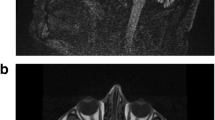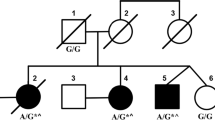Abstract
Two French-Canadian sibs with cerebellar ataxia and dysarthria were seen in our neurogenetics clinic. The older brother had global developmental delay and spastic paraplegia. Brain MRIs from these two affected individuals showed moderate to severe cerebellar atrophy. To identify the genetic basis for their disease, we conducted a whole exome sequencing (WES) investigation using genomic DNA prepared from the affected sibs and their healthy father. We identified two mutations in the SIL1 gene, which is reported to cause Marinesco-Sjögren syndrome. This study emphasizes how the diagnosis of patients with ataxic gait and cerebellar atrophy may benefit from WES to identify the genetic cause of their condition.


Similar content being viewed by others
References
Jayadev S, Bird TD (2013) Hereditary ataxias: overview. Genet Med: official J Am College Med Genet 15(9):673–683
Martineau L, Noreau A, Dupre N (2014) Therapies for ataxias. Curr Treat Options Neurol 16(7):300
van de Warrenburg BP, van Gaalen J, Boesch S, et al. (2014) EFNS/ENS consensus on the diagnosis and management of chronic ataxias in adulthood. Eur J Neurol 21(4):552–562
Krieger M, Roos A, Stendel C, et al. (2013) SIL1 mutations and clinical spectrum in patients with Marinesco-Sjogren syndrome. Brain 136(Pt 12):3634–3644
Horvers M, Anttonen AK, Lehesjoki AE, et al. (2013) Marinesco-Sjogren syndrome due to SIL1 mutations with a comment on the clinical phenotype. Eur J Paediatr Neurol 17(2):199–203
Lagier-Tourenne C, Tranebaerg L, Chaigne D, et al. (2003) Homozygosity mapping of Marinesco-Sjogren syndrome to 5q31. Eur J Hum Genet 11(10):770–778
Anttonen AK, Mahjneh I, Hamalainen RH, et al. (2005) The gene disrupted in Marinesco-Sjogren syndrome encodes SIL1, an HSPA5 cochaperone. Nat Genet 37(12):1309–1311
Anheim M, Fleury M, Monga B, et al. (2010) Epidemiological, clinical, paraclinical and molecular study of a cohort of 102 patients affected with autosomal recessive progressive cerebellar ataxia from Alsace, Eastern France: implications for clinical management. Neurogenetics 11(1):1–12
Senderek J, Krieger M, Stendel C, et al. (2005) Mutations in SIL1 cause Marinesco-Sjogren syndrome, a cerebellar ataxia with cataract and myopathy. Nat Genet 37(12):1312–1314
Biesecker LG, Green RC (2014) Diagnostic clinical genome and exome sequencing. N Engl J Med 370(25):2418–2425
Zhao L, Longo-Guess C, Harris BS, Lee JW, Ackerman SL (2005) Protein accumulation and neurodegeneration in the woozy mutant mouse is caused by disruption of SIL1, a cochaperone of BiP. Nat Genet 37(9):974–979
Acknowledgments
We are grateful to the patients and their parents for their participation in this study. A.N. holds a Doctoral Award—Frederick Banting and Charles Best Graduate Scholarship by the Canadian Institutes of Health Research (CIHR) and a post-doctoral fellowship from the Fonds de Recherche du Québec en Santé (FRQS). R.L.P. received the Preston-Robb fellowship from the Montreal Neurological Institute and a doctoral scholarship from the Fonds de Recherche du Québec en Santé (FRQS). G.B. has received a Research Scholar Junior 1 award from the Fonds de Recherche du Québec en Santé (FRQS). G.A.R. holds a Canada Research Chair for the Genetics of Brain Diseases and is supported by the RMGA and the Canadian Institutes of Health Research. This work was selected for study by the FORGE Canada Steering Committee, consisting of K. Boycott (University of Ottawa), J. Friedman (University of British Columbia), J. Michaud (University of Montreal), F. Bernier (University of Calgary), M. Brudno (University of Toronto), B. Fernandez (Memorial University), B. Knoppers (McGill University), M. Samuels (University of Montreal), and S. Scherer (University of Toronto). We would also like to thank the McGill University and Genome Quebec Innovation Center.
Conflict of interest
The authors declare that they have no competing interests.
Author information
Authors and Affiliations
Consortia
Corresponding author
Rights and permissions
About this article
Cite this article
Noreau, A., La Piana, R., Marcoux, C. et al. Novel SIL1 mutations cause cerebellar ataxia and atrophy in a French-Canadian family. Neurogenetics 16, 315–318 (2015). https://doi.org/10.1007/s10048-015-0455-z
Received:
Accepted:
Published:
Issue Date:
DOI: https://doi.org/10.1007/s10048-015-0455-z




